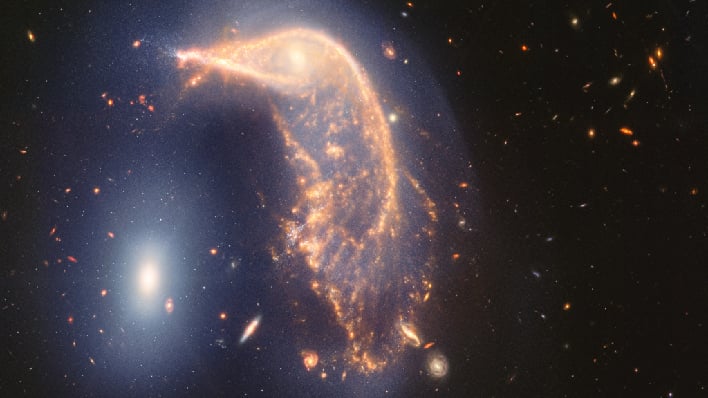NASA’s James Webb Space Telescope celebrates its two-year science anniversary with a spectacular image of a pair of interacting galaxies. The eloquent cosmic embrace of the spiral galaxy at the center of the image above, known as the Penguin, and the compact elliptical galaxy to the left, known as the Egg, are comprised of images from Webb’s NIRCam and MIRI instruments.
While some may find it surprising that NASA’s Webb telescope has been sending back images from deep space for two years already, others may feel as though the space telescope has been around for much longer because of the sheer amount of data it has already delivered, and the science it has spurred, which has already challenged formation theories. From the first image shared by President Biden and Vice President Harris in 2022, to the Penguin and the Egg, also known as Arp 142, Webb has certainly began unveiling the Universe in new and unique ways.
“In just two years, Webb has transformed our view of the universe, enabling the kind of world-class science that drove NASA to make this mission a reality,” remarked Mark Clampin, director of the Astrophysics Division at NASA Headquarters in Washington. “Webb is providing insights into longstanding mysteries about the early universe and ushering in a new era of studying distant worlds, while returning images that inspire people around the world and posing exciting new questions to answer. It has never been more possible to explore every facet of the universe.”
Webb shows off one of its specialties in the image of Arp 142, capturing the duo of galaxies in infrared light, or light that is beyond what the human eye can see. By being able to combine near-and-mid-infrared light from its NIRCam (Near-Infrared Camera) and MIRI (Mid-Infrared Instrument), Webb reveals the two galaxies joined by “a haze represented in blue that is a mix of stars and gas, a result of their mingling.”
According to NASA, the ongoing interaction between the duo began between 25 and 75 million years ago, when the Penguin and the Egg completed their first pass of one another. The space agency remarked that millions of years from now, the partners will merge into a single galaxy.
The two galaxies are considered close to one another in astronomical terms, about 100,000 light-years apart. In comparison, the Milky Way galaxy and its closest neighbor, the Andromeda galaxy, are about 2.5 million light-years apart. Much like the Penguin and the Egg, the Milky Way and Andromeda galaxies will one day interact similarly, but not for about 4 billion years, according to NASA.
